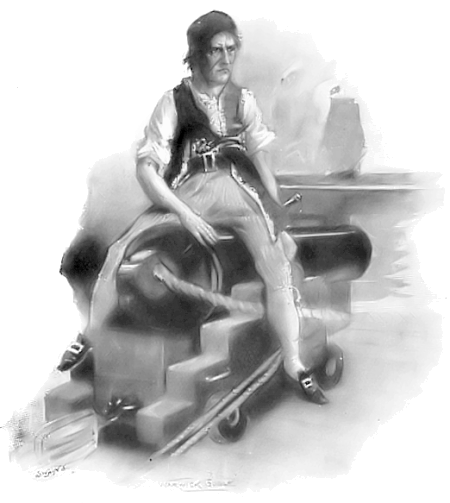 Captain John Sharkey, May 1897, Pearson's Magazine
Captain John Sharkey, May 1897, Pearson's Magazine
 Philip A. Shreffler, visiting the submarine USS Missouri
Philip A. Shreffler, visiting the submarine USS Missouri
Described as having a clean-shaven face, corpse-like in its pallor, a high bald forehead, a long, thin, high-nostrilled nose, and perhaps his most distinctive feature filmy blue eyes, red-rimmed like those of a white bull terrier, from which strong men winced away in fear and loathing.
The pirates of history, from ancient Greece to modern Somalia, and certainly during the golden age of piracy from 1650 to 1720, are pretty uniformly far less appealing than those of fiction.
One only has to think, for example, of Robert Louis Stevenson’s Long John Silver, who is alternately treacherous and likeable, villainous yet sympathetic, and compare him to the almost psychotically murderous sea rovers of piracy’s golden age. However, Arthur Conan Doyle turned this literary formula on its head in his stories about the pirate Captain John Sharkey, who is not only as degradedly evil as any actual pirate, but, in fact, pirated a lot of his behavior from his historical counterparts.
Physically, Sharkey is described as having a “clean-shaven face…corpse-like in its pallor,” “a high, bald forehead,” a “long, thin, high-nostrilled nose,” and—perhaps his most distinctive feature—“filmy blue eyes, red-rimmed like those of a white bull terrier, from which strong men winced away in fear and loathing.” Despite the tropical heat of the Caribbean, he affects a “low fur cap” and in one story wears a blousy cambric shirt under a “red satin long-flapped vest [waistcoat],” a sword suspended from a “many-colored band of silk” that “passed across his body” (instead of a leather baldric, and not uncommon among pirates of his period), and a “brass-buckled belt stuffed with pistols.”
The Sharkey tales are centered around the year 1720, and from the North American coast south into the Caribbean Sea, just at the time and place when the last of the most famous and ruthless pirates were being systematically extirpated from the seas. Sharkey’s ship, the “ambiguously-named” Happy Delivery, is a sleek black barque, a “ship of death” the very sight of which terrifies experienced mariners. This pirate captain and his bloodthirsty crew are responsible for the sacking and sinking of dozens of ships, and the murder of scores of people regardless of age, sex or social position, and their depredations are sometimes described in gory detail.
In composing the Sharkey adventures, Conan Doyle had done the requisite research, almost certainly having consulted Charles Johnson’s extremely popular General History of the Pyrates (1764, and often wrongly attributed to Daniel Defoe), Charles Ellms’ The Pirates Own Book (1837), both published in English, and possibly even Alexander Exquemelin’s History of the Buccaneers of America (1678), originally published in Dutch and translated into English in 1684.
Conan Doyle’s thumbnail sketches of the devolution of the sea raiders, from the slightly more honorable buccaneers of the mid-seventeenth century to the murderous pirates of the early eighteenth, “Ishmaels of the sea” who are “at war with the world,” are entirely accurate. So also are specific instances of piratical cruelty, like cutting the lips off a captured skipper and serving them up in front of him “with pepper and salt,” an outrage committed by the historical Captain Edward (“Ned”) Low recounted in Johnson’s General History.
Sharkey’s own most shocking behavior is similarly drawn from historical sources. In a fit of rage, Sharkey kills his own ship’s carpenter Jack Bartholomew by braining him with a wooden bucket—just as Captain Kidd murdered his mutinous gunner William Moore the same way, as reported by Charles Johnson from Kidd’s trial records. In another episode, aboard a captured merchantman, Sharkey “fastened her master to the windlass and pelted him to death with empty claret bottles.” According to The Pirates’ Own Book, Captain Edward England’s crew “laid hold of [a captive ship’s commander], tied him fast to the windlass, and pelted him with glass bottles until they cut him in a shocking manner.” After further tortures, the pirates “shot him through the head.”
(Each pirate captain, by the way, designed and flew his own version of the black flag. Edward England’s was the classic we know today, a skull over crossed bones, while others featured variations, and sometimes entire skeletons or other devices designed to inspire terror. In the Sharkey stories, a black flag of some sort was flown at the mizzen, a warning to the pirates’ prey to surrender. But Sharkey always flew a red pennant as well, this flag intended to announce that no quarter was to be given.)
The darkly colorful Edward Teach, known as Blackbeard, is also invoked in Sharkey’s crossing a pair of pistols under a table during a card game, firing blindly and crippling his boatswain, just as Blackbeard is reported to have don to his second-in-command Israel Hands (a name appropriated by Stevenson for a character in Treasure Island). And both Conan Doyle’s Sharkey and the historical Teach act from the same motive. “I see well that if I do not shoot one of you from time to time,” says Sharkey, “you will forget the man I am.” The General History of the Pyrates remarks that Blackbeard, “damning [his crew],” said “that if he did not now and then kill one of them, they would forget who he was.”
In composing the Captain Sharkey adventures, despite perhaps slightly romanticized plot lines and unlikely turns of events, Conan Doyle clearly sought to present the pirates of the Caribbean as they actually were, based on the best source material available to him. John Sharkey is no children’s pirate, but instead representative of his historic brethren: cunning, merciless, cruel and brutal. And his blood-soaked life of crime is surprisingly brief (there are just four stories in the series), echoing the one-to-five year careers of the historical pirates, until Sharkey’s own grisly death expunges him from the world he so dourly hates.
--
Written by Philip A. Shreffler, a lay dabbler in subjects ranging from astrophysics, archaeology and anthropology to revolutionaries, outlaws and even monsters (literary, cinematic and folkloric), is a retired Professor of English, an avid sailor and yacht club member, and a past Flotilla Commander in the U.S. Coast Guard Auxiliary. “Jefferson Hope” in The Baker Street Irregulars, he edited its Baker Street Journal for a decade, and has authored or edited half a dozen books about Sherlock Holmes and other literary subjects. A native of St. Louis, Missouri (seen above alongside the nuclear submarine USS Missouri), he keeps an eye out for pirates near the sea in Deep River, Connecticut.

